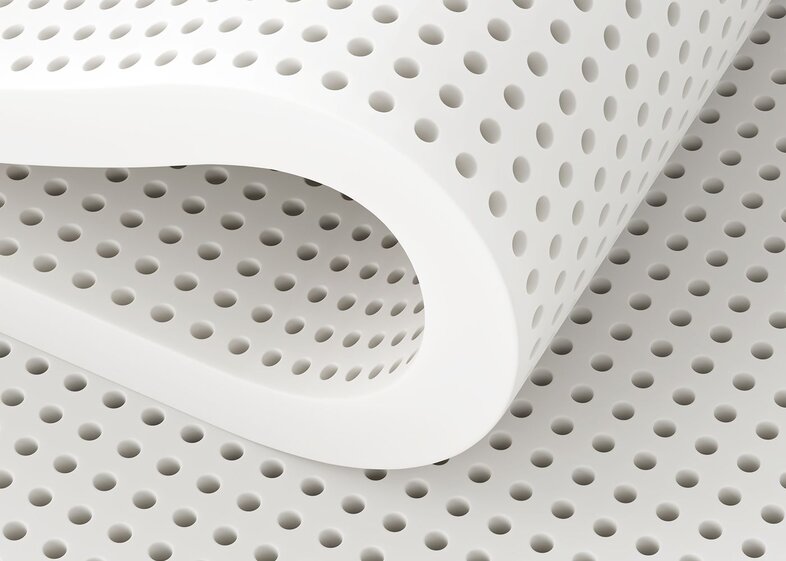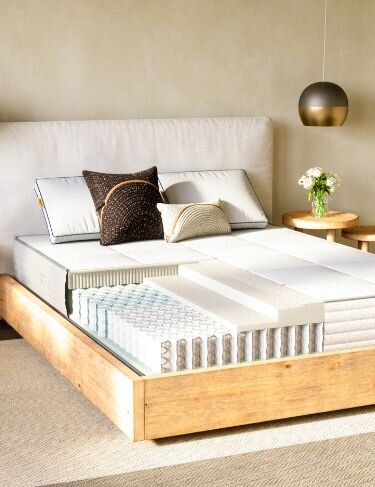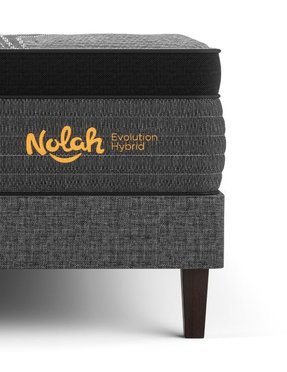What Is a Latex Mattress?
What Is a Latex Mattress?
Latex mattresses are supportive, pressure-relieving, and highly durable beds known for their slightly “bouncy” and responsive foam feel. Many shoppers consider them the most eco-friendly mattress option because the liquid latex used to make the foam comes from a natural source: rubber trees. Natural latex mattresses also have a reputation for longevity, with some high-end models lasting as long as 20 years.
In this guide, we’ll cover what latex foam feels like, how it’s made, and how latex mattresses stack up against other mattress types. Also, stay tuned to find out what factors you should consider before investing in a latex bed and how to take care of your new mattress once it arrives.
Latex Mattress Types
If you're considering latex, you should understand all your options before you start browsing beds. Under the latex mattress umbrella, models vary in construction and foam composition. You'll likely encounter these latex subcategories as you shop.
Mattress Construction
All-Foam Latex Mattresses
You guessed it, all-foam latex mattresses exclusively use layers of latex foam for cushioning and support. Most high-quality options feature at least three foam layers of varying heights and densities, providing comfortable contouring up top and more structure and support underneath.
Latex Hybrid Mattresses
Latex hybrid mattresses combine latex foam comfort layers with a coil support core underneath. While the upper latex layers contour to your curves and relieve the pressure, the coils bolster strength, durability, support, and responsiveness. They also improve edge support, a quality many all-foam mattresses lack. To learn more about hybrid beds, check out our article What Is a Hybrid Mattress and Should You Buy One?
Types of Latex Foam
Natural Latex: Talalay vs. Dunlop
In our opinion, the best latex mattresses use natural latex foam. It starts as liquid latex, most commonly harvested from Hevea brasiliensis (rubber) trees. Next, manufacturers mix the liquid latex with additives, froth it, and pour it into a mold to bake and cure. However, the exact steps vary depending on the type of latex in production: Dunlop or Talalay.
Our Dunlop vs. Talalay Latex guide discusses the two processing methods for natural latex foam in detail. While they have their differences, they're both highly durable, responsive, and supportive materials, ideal for eco-friendly mattresses.
Synthetic Latex and Blended Latex
While this article focuses on natural latex, you'll find mattresses made with synthetic or blended latex designed to imitate natural latex foam. Made with petrochemicals, synthetic latex isn't as durable or breathable as natural latex.

Latex Mattress Benefits
There's so much to love about latex. Here's what makes natural latex an ideal material for both all-foam and hybrid mattresses:
1. Comfortable and Supportive
Latex foam soothes your joints while supporting your spine. The foam has a subtle bounce that restless sleepers love; it contours to your curves and then quickly bounces back to its original shape when you remove pressure. Latex also offers excellent pressure relief, dispersing body weight and reducing tension around sensitive joints. Many latex mattresses feature denser foam for the base layers to deepen support and add structure.
2. Fit for Any Sleeper
Latex mattresses have wide appeal. Manufacturers can produce latex foam in a range of firmness levels, so sleepers of all ages, body types, and sleep positions can find a comfortable option that offers the right balance between cushioning and support.
3. Cool and Breathable
If you sleep hot, you’ll love the cooling relief of latex. Unlike memory foam, natural latex foam is temperature-neutral and doesn’t trap body heat. The foam also has a highly breathable structure, letting fresh air flow through.
4. Eco-Friendly and Natural
As we discussed previously, natural latex foam starts as liquid latex tapped from rubber trees. When done responsibly, harvesting latex is a sustainable practice. Tapping the serum doesn’t harm the trees, and farmers can harvest latex from a single rubber tree for about 28 years of the tree’s 100-year lifespan.
Depending on the farming and manufacturing processes, some natural latex foam is also hypoallergenic, organic, and biodegradable. You can look for certifications from trusted third-party organizations to find a latex mattress free from harsh or harmful chemicals.
5. Highly Durable
Latex mattresses also boast impressive durability. Thanks to the latex foam’s natural resilience, a high-quality latex mattress can last as long as 20 years. The foam resists sagging longer than synthetic alternatives and maintains its firmness and responsive bounce.
Latex Mattress Potential Concerns and Drawbacks
Of course, no bed is perfect. Below, we discuss the cons of latex mattresses.
1. Price
Latex foam is a premium natural mattress material, so latex mattresses typically cost more than their memory foam and polyfoam counterparts. However, they’re more durable, making them a practical long-term investment.
2. Options
Latex and latex hybrid mattresses aren’t as common as memory foam and polyfoam, so you’ll have fewer models to choose from. Fortunately, latex mattresses are highly versatile and suit a wide range of sleepers; if you decide on latex for your next bed, you shouldn’t have difficulty finding a comfortable fit for your weight and sleep position.
3. Weight
These heavy-duty models are heavier than other mattress types, so set-up and relocation typically require two people and some planning.
How Do Latex Mattresses Compare to Other Mattress Types?
Latex vs. Memory Foam Mattresses
While they’re both made of foam, memory foam and latex mattresses have two distinct feels. Latex mattresses are known for their buoyancy and responsiveness, while “memory foam” gets its name from its slow response and close contouring. Latex foam makes you feel like you’re floating on top of your mattresses whereas memory foam makes you feel cushioned within the mattress.
Another key difference between latex foam and memory foam is temperature. As mentioned above, latex foam is highly breathable and temperature neutral, offering cooling relief in any season. On the other hand, memory foam requires heat to contour. It gets its flexibility from viscoelastic chemicals, which trap heat within the foam.
Latex vs. Innerspring Mattresses
Compared to traditional innerspring mattresses, latex mattresses offer more cushioning comfort and pressure relief. The foam gently contours to your curves and soothes your joints, both areas where innerspring mattresses fall short. However, innerspring mattresses offer better edge support than all-foam latex mattresses because they offer more structure around the perimeter.
Buying a Latex Mattress: Key Considerations
Does latex sound like your dream sleep solution? If you’ve decided on natural latex as the main material for your next bed, you’re almost there! Decide on the following factors, and you’ll find your ideal mattress in no time.
Latex vs. Latex Hybrid
As previously mentioned, mattress brands use latex foam for two mattress types: 1) all-foam latex models and 2) latex hybrid models.
Both latex mattress varieties are cool, durable, highly responsive, and pressure-relieving. Latex hybrid mattresses typically cost more, but they also offer more structure, deeper support, and stronger edges thanks to their coil core.
Firmness Level
Your optimal firmness level depends on your sleep position, weight, and contouring preferences. While most latex mattresses skew to the firmer end, you can find high-quality options at all points of the mattress firmness scale.
If you aren’t sure what firmness level works best for you or your sleeping partner, check out our Mattress Firmness Guide. Some mattress manufacturers use impression load deflection (ILD) to measure firmness for latex mattresses, so our guide includes mattress feel equivalences for ILD ratings.
Latex Mattress Maintenance and Care
How Long Does a Natural Latex Mattress Last?
With proper care, a high-quality natural latex mattress can last up to about 20 years. However, you may wish to replace your mattress sooner than the 20-year mark for sanitary reasons.
Do Latex Mattresses Sag Over Time?
Yes, all mattresses eventually sag—but natural latex and latex hybrid mattresses are the most durable mattress types and retain their structure and firmness longer than their memory foam counterparts. Here’s what you can do to slow down sagging and prevent wear and tear:
Follow the manufacturer’s recommendations for a proper base, bed frame, or foundation
Use a mattress protector or mattress topper
Rotate your mattress 180 degrees every six months to spread out impressions
How Do You Clean a Latex Mattress?
Always follow the manufacturer’s directions for stain treatment and spot cleaning. Many mattress makers recommend DIY solutions using household materials like baking soda, hydrogen peroxide, and gentle laundry detergent. When cleaning a latex (or any foam) mattress, it’s important not to soak the foam and to let it dry completely before making the bed.
Relax with Latex
With that, we’ve covered everything you need to know about buying and owning a latex mattress! At Nolah, we offer a premium natural latex hybrid option: the Nolah Natural.

This 11-inch, six-layer mattress features a breathable organic cotton cover, organic latex, and individually-wrapped recycled steel coils. It has a medium-firm feel, perfect for most side, back, and combination sleepers. We hope you fall in love with the responsive feel of latex and find it easy to relax and drift off to sleep on this pressure-relieving bed.
Frequently Asked Questions
About Latex Mattresses
Disclaimer: Nolah does not provide medical advice. All resources on the Nolah blog, including this article, are informational only and do not replace professional medical counsel. Talk to your doctor about any health, mental health, or sleep-related issues.
You May Also Like These Articles
Don't Sleep on Exclusive Offers
Sign up for our newsletter, and you'll be the first to know about discounts, deals, and what's new at Nolah.
Ready for Bed?
